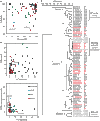New evidence of broader diets for archaic Homo populations in the northwestern Mediterranean
- PMID: 30854435
- PMCID: PMC6402852
- DOI: 10.1126/sciadv.aav9106
New evidence of broader diets for archaic Homo populations in the northwestern Mediterranean
Abstract
Investigating diet breadth is critical for understanding how archaic Homo populations, including Neanderthals, competed for seasonally scarce resources. The current consensus in Western Europe is that ungulates formed the bulk of the human diet during the Lower and Middle Paleolithic, while small fast prey taxa were virtually ignored. Here, we present a multisite taphonomic study of leporid assemblages from Southern France that supports frequent exploitation of small fast game during marine isotope stages 11 to 3. Along with recent evidence from Iberia, our results indicate that the consumption of small fast game was more common prior to the Upper Paleolithic than previously thought and that archaic hominins from the northwestern Mediterranean had broader diets than those from adjacent regions. Although likely of secondary importance relative to ungulates, the frequent exploitation of leporids documented here implies that human diet breadths were substantially more variable within Europe than assumed by current evolutionary models.
Figures




References
-
- L. R. Binford, Constructing Frames of Reference: an Analytical Method for Archaeological Theory Building Using Ethnographic and Environmental Data Sets (University of California Press, 2001).
-
- J. D. Speth, The Paleoanthropology and Archaeology of Big-Game Hunting: Protein, Fat, or Politics? (Springer, New York, 2010).
-
- E. A. Smith, Inujjuamiut Foraging Strategies. Evolutionary Ecology of an Arctic Hunting Economy (Aldine de Gruyter, New York, 1991).
-
- Bird D. W., Bird R. B., Codding B. F., In pursuit of mobile prey: Martu hunting strategies and archaeofaunal interpretation. Am. Antiq. 74, 3–29 (2009).
-
- Blasco R., Rosell J., Peris J. F., Arsuaga J. L., de Castro J. M. B., Carbonell E., Environmental availability, behavioural diversity and diet: A zooarchaeological approach from the TD10-1 sublevel of Gran Dolina (Sierra de Atapuerca, Burgos, Spain) and Bolomor Cave (Valencia, Spain). Quat. Sci. Rev. 70, 124–144 (2013).
Publication types
MeSH terms
LinkOut - more resources
Full Text Sources

